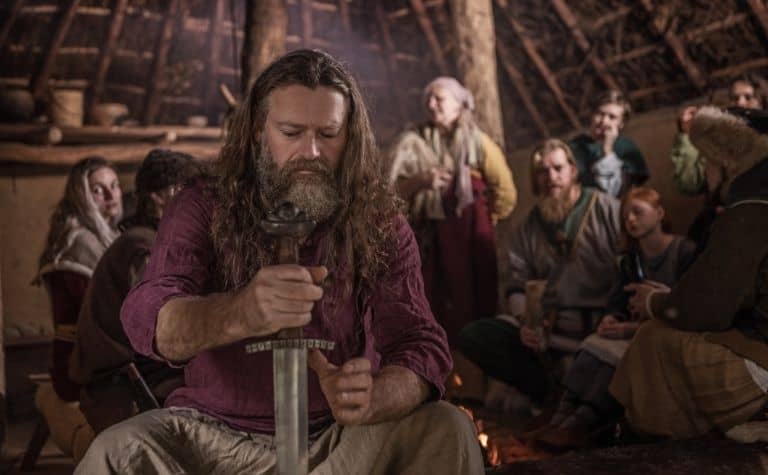Though their heyday was centuries ago during the Middle Ages, the Vikings are just as infamous and relevant today as they have ever been.
They are a regular presence in modern pop culture, and their stature as legendary warriors has not waned a bit since the Viking Age ended nearly a millennium ago. Even their jargon lives on, including most famously, the Viking term “skol.”
Skol is derived from the Scandinavian word skål, which originally referred to a communal wooden bowl passed from person to person at social gatherings and later meant to toast.
While definitive historical proof is lacking, many believe that the Vikings used the word skol to say “cheers!”
To their enemies, they were fearsome and merciless. However, within their ranks, they were unified with a common purpose: to fight with courage and vanquish their opponents. Keep reading to learn more.
Also see Dane Axes in the Viking Age to learn more.

What Does Skol Mean?
The word skol is a derivative form of skål, an Old Norse word for a wooden bowl from which beer and other alcoholic beverages were consumed by attendees at social gatherings or participants in certain ceremonies. [1]
Because a communal skål would be passed from person to person, the word evolved to take on a second, and perhaps more significant, meaning of a toast or salutation. (Also see This Is How the Vikings Proposed and Got Married)
Today, skål is still a vibrant part of the Scandinavian vernacular and retains the same connotation of goodwill and camaraderie in Danish, Norwegian, and Swedish cultures.
For instance, in Sweden, skål can be used in the following ways:
- To mean “cheers!” as in skål fӧr vӓnskap (cheers to friendship) or skål på dig (cheers to you)
- By itself, skål! would translate to “cheers!”
- As a verb, skåla means to toast or drink in honor of, as in ska vi skåla fӧr det? (shall we drink to that?) [2]
Thus it is evident that at least in terms of its modern usage, the context within which skål is typically used revolves around feelings of camaraderie and goodwill in social settings, particularly where spirits and like beverages are involved. (Also see This Is What the Vikings Did for Fun)
Also see Norsemen vs Vikings: What’s the Difference? to learn more.

When Would Vikings Say Skol?
Certain aspects of Viking culture and society continue to elude historians as they try to piece together a complete picture of how the Vikings lived.
Since the Vikings did not record their own history, scholars are sometimes left to fill in some gaps based on conjecture or educated guesses.
Such would be the case regarding how they interacted and conversed with one another.
It is not known how exactly (or technically, even whether) the Vikings used the word skol but given the word’s origins and based on what is known about Viking traditions and social practices, it is likely that skol was a term of fellowship and goodwill toward a compatriot. [3]
And like modern Scandinavians and their use of the word skål, when the Vikings said skol to one another, there was likely alcohol involved.
It is beyond dispute that alcohol played an important role in Viking social and ceremonial activities.
As a practical matter, it is possible that the Vikings drank more ale than water because ale would be sterilized through the fermentation process and therefore be safer to consume. (Also see Vikings Recipes: How Did They Make Ale?)
Regardless, the Vikings viewed alcohol in its various forms as far more than just a beverage with intoxicating qualities.
Here are just a few examples of the central role alcohol played in various aspects of Viking life:
- It was consumed to formalize agreements such as treaties, sale of property, and even marriage contracts
- Alcohol was involved in the finalization of wills and settling estates of the deceased
- Only poets and scholars drank mead (one of the most famous of Norse myths involves the mead of poetry)
- As alcohol was gifted to humans by the Norse gods, Vikings were expected to share it amongst themselves
- Mead halls were a central gathering place where chieftains rewarded their followers for their loyalty by lavishing them with food and drink
- Toasting to the Norse gods was a practice that was strictly followed at many gatherings (it is said that the first three drinks at any mead hall event were poured in honor of the Norse gods, with Odin always being the first honoree)
- Oaths made over alcohol were the most binding of all promises [4]
With so many scenarios where Vikings fraternized with one another and alcohol consumption was expected, it would not be a stretch of the imagination to presume that many a skol would have passed through the drunken lips of attendees of these festivities.
Also see Vikings vs Samurai: What’s the Difference? to learn more.
What is the Viking Skol Clap?
In 2016, the national soccer team of Iceland made a historic and highly improbable run through the Euro 2016 soccer tournament. [5]
Not only did the Icelandic footballers advance past the group stage, but they also scored an epic victory over international soccer powerhouse England to advance to the quarterfinals (where they lost to France).
Along the way, the Iceland national team earned the respect of the global soccer community, and Iceland’s loyal fanbase made headlines for their Viking-inspired war chant that mesmerized entire stadiums and went viral on social media. Here is how the chant unfolds:
- All fans stand with their hands outstretched over their heads
- As a large drum on the field is beat twice, the fans clap once in unison and chant “hoo”
- The pace quickens between drum beats, and the clapping and chanting intensify
- At the culmination of the Icelandic Viking chant, the drum beats and claps are nearly simultaneous, and it ends as the crowd erupts into a thunderous cheer [6]
Although they were eliminated in the round of eight, Iceland’s national team returned home to a hero’s welcome and a celebratory Viking clap (which can be watched here).
So stirring were the Icelandic Viking chants that fans of another type of football team based over three thousand miles away had designs on implementing their own version of the Icelanders’ homage to their Viking ancestry. [7]
Why do Vikings Football Fans Say Skol?
When the Minnesota Vikings played their inaugural season in 1961, a local musician from Edina, MN, composed the team’s fight song, “Skol Vikings.” [8]
But it was not until 55 years later, in 2016, when the Minnesota Vikings began playing home games in their newly constructed, state-of-the-art stadium, that a new tradition was born and immediately embraced by Vikings fans: the skol chant.
With the blessing of the Icelandic soccer team, the Minnesota Vikings begin every home game at U.S. Bank Stadium with their rendition of the Viking clap made famous by Icelanders during international soccer matches.
In the few short years that the Vikings fans have performed skol chant, it has become nothing short of a true spectacle:
- Like the Icelandic soccer fans, all Vikings fans rise from their seats and hold their hands over their heads
- Instead of chanting “hoo” following the drum beats, Vikings fans clap and shout “skol”
- At the conclusion of the chant, a guest of honor “blows” the colossal Gjallarhorn (a mythical Viking battle horn) at one end of the field to signal the start of the battle on the gridiron. [9]
Just as the Vikings centuries ago reputedly greeted and toasted each other with a hearty skol, so too do the Minnesota Vikings’ fans of the use the term to express a shared (and often, very passionate) love for their football team.
Minnesota’s Scandinavian Ancestry
The Minnesota Vikings of the National Football League (NFL) are known as such because of the character and courage that the legendary Vikings represent.
But being named after the fearsome Norse warriors is not the only reason that this famous NFL franchise is known as the Vikings; the name also serves as recognition of the strong Scandinavian presence in Minnesota that dates back to the 19th century.
The United States is often referred to as a great melting pot of cultures, and in the case of Minnesota, that diversity of differing heritages has a strong Scandinavian flavor.
In fact, over 30% of Minnesotans (roughly 1.5 million people) claim Scandinavian ancestry, [10] and Norway has a particularly strong representation among today’s population of the Land of 10,000 Lakes. [11]
Final Thoughts
The Viking spirit lives on throughout Scandinavia, in Iceland, and even the United States, where passionate chants of “skol” reverberate to this day.
References:
[1] Source
[2] Source
[3] Source
[4] Source
[5] Source
[6] Source
[7] Source
[8] Source
[9] Source
[10] Source
[11] Source
